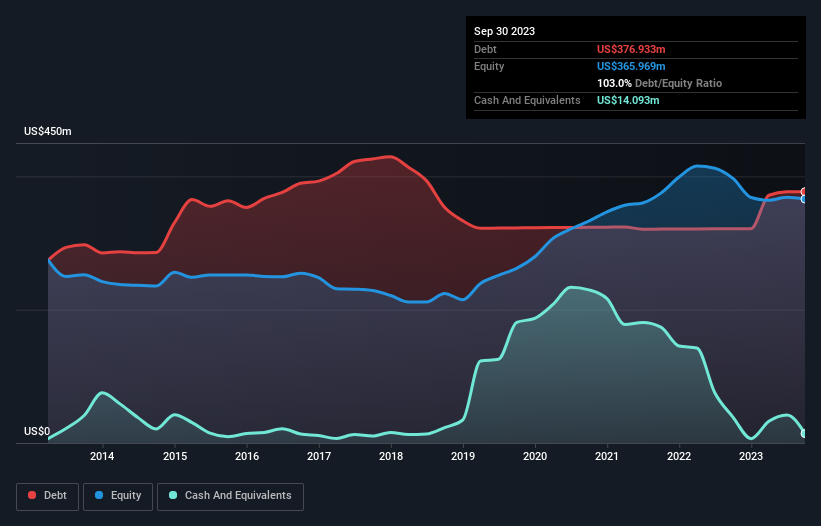- United States
- /
- Construction
- /
- NasdaqGS:GLDD
Great Lakes Dredge & Dock (NASDAQ:GLDD) Has Debt But No Earnings; Should You Worry?

Some say volatility, rather than debt, is the best way to think about risk as an investor, but Warren Buffett famously said that 'Volatility is far from synonymous with risk.' It's only natural to consider a company's balance sheet when you examine how risky it is, since debt is often involved when a business collapses. Importantly, Great Lakes Dredge & Dock Corporation (NASDAQ:GLDD) does carry debt. But should shareholders be worried about its use of debt?
What Risk Does Debt Bring?
Debt is a tool to help businesses grow, but if a business is incapable of paying off its lenders, then it exists at their mercy. Ultimately, if the company can't fulfill its legal obligations to repay debt, shareholders could walk away with nothing. While that is not too common, we often do see indebted companies permanently diluting shareholders because lenders force them to raise capital at a distressed price. Of course, plenty of companies use debt to fund growth, without any negative consequences. When we examine debt levels, we first consider both cash and debt levels, together.
See our latest analysis for Great Lakes Dredge & Dock
How Much Debt Does Great Lakes Dredge & Dock Carry?
The image below, which you can click on for greater detail, shows that at September 2023 Great Lakes Dredge & Dock had debt of US$376.9m, up from US$321.4m in one year. However, it also had US$14.1m in cash, and so its net debt is US$362.8m.

How Healthy Is Great Lakes Dredge & Dock's Balance Sheet?
We can see from the most recent balance sheet that Great Lakes Dredge & Dock had liabilities of US$164.4m falling due within a year, and liabilities of US$489.9m due beyond that. On the other hand, it had cash of US$14.1m and US$79.6m worth of receivables due within a year. So its liabilities total US$560.6m more than the combination of its cash and short-term receivables.
Given this deficit is actually higher than the company's market capitalization of US$506.9m, we think shareholders really should watch Great Lakes Dredge & Dock's debt levels, like a parent watching their child ride a bike for the first time. In the scenario where the company had to clean up its balance sheet quickly, it seems likely shareholders would suffer extensive dilution. When analysing debt levels, the balance sheet is the obvious place to start. But ultimately the future profitability of the business will decide if Great Lakes Dredge & Dock can strengthen its balance sheet over time. So if you want to see what the professionals think, you might find this free report on analyst profit forecasts to be interesting.
In the last year Great Lakes Dredge & Dock had a loss before interest and tax, and actually shrunk its revenue by 22%, to US$555m. To be frank that doesn't bode well.
Caveat Emptor
While Great Lakes Dredge & Dock's falling revenue is about as heartwarming as a wet blanket, arguably its earnings before interest and tax (EBIT) loss is even less appealing. Indeed, it lost US$31m at the EBIT level. Considering that alongside the liabilities mentioned above make us nervous about the company. It would need to improve its operations quickly for us to be interested in it. Not least because it had negative free cash flow of US$81m over the last twelve months. So suffice it to say we consider the stock to be risky. There's no doubt that we learn most about debt from the balance sheet. But ultimately, every company can contain risks that exist outside of the balance sheet. Case in point: We've spotted 1 warning sign for Great Lakes Dredge & Dock you should be aware of.
At the end of the day, it's often better to focus on companies that are free from net debt. You can access our special list of such companies (all with a track record of profit growth). It's free.
New: Manage All Your Stock Portfolios in One Place
We've created the ultimate portfolio companion for stock investors, and it's free.
• Connect an unlimited number of Portfolios and see your total in one currency
• Be alerted to new Warning Signs or Risks via email or mobile
• Track the Fair Value of your stocks
Have feedback on this article? Concerned about the content? Get in touch with us directly. Alternatively, email editorial-team (at) simplywallst.com.
This article by Simply Wall St is general in nature. We provide commentary based on historical data and analyst forecasts only using an unbiased methodology and our articles are not intended to be financial advice. It does not constitute a recommendation to buy or sell any stock, and does not take account of your objectives, or your financial situation. We aim to bring you long-term focused analysis driven by fundamental data. Note that our analysis may not factor in the latest price-sensitive company announcements or qualitative material. Simply Wall St has no position in any stocks mentioned.
About NasdaqGS:GLDD
Great Lakes Dredge & Dock
Provides dredging services in the United States.
Very undervalued with proven track record.
Similar Companies
Market Insights
Community Narratives



